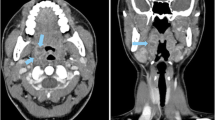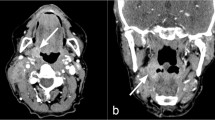Abstract
Introduction
Low tube voltage allows for computed tomography (CT) imaging with increased iodine contrast at reduced radiation dose. We sought to evaluate the image quality and potential dose reduction using a combination of attenuation based tube current modulation (TCM) and automated tube voltage adaptation (TVA) between 100 and 120 kV in CT of the head and neck.
Methods
One hundred thirty consecutive patients with indication for head and neck CT were examined with a 128-slice system capable of TCM and TVA. Reference protocol was set at 120 kV. Tube voltage was reduced to 100 kV whenever proposed by automated analysis of the localizer. An additional small scan aligned to the jaw was performed at a fixed 120 kV setting. Image quality was assessed by two radiologists on a standardized Likert-scale and measurements of signal- (SNR) and contrast-to-noise ratio (CNR). Radiation dose was assessed as CTDIvol.
Results
Diagnostic image quality was excellent in both groups and did not differ significantly (p = 0.34). Image noise in the 100 kV data was increased and SNR decreased (17.8/9.6) in the jugular veins and the sternocleidomastoid muscle when compared to 120 kV (SNR 24.4/10.3), but not in fatty tissue and air. However, CNR did not differ statistically significant between 100 (23.5/14.4/9.4) and 120 kV data (24.2/15.3/8.6) while radiation dose was decreased by 7–8 %.
Conclusions
TVA between 100 and 120 kV in combination with TCM led to a radiation dose reduction compared to TCM alone, while keeping CNR constant though maintaining diagnostic image quality.



Similar content being viewed by others
Abbreviations
- CT:
-
Computed tomography
- TCM:
-
Tube current modulation
- TVA:
-
Tube voltage adaptation
- HU:
-
Hounsfield units
- ROI:
-
Regions of interest
- SNR:
-
Signal-to-noise ratio
- CNR:
-
Contrast-to-noise ratio
References
Agency HP, Centre for Radiation CaEH, Division RP (2008) European Commission Radiation Protection N° 154, European guidance on estimating population doses from medical X-Ray procedures, Annex 1 – DD Report 1 Review of recent National Surveys of Population Exposure from Medical X-rays in Europe. vol 154. Chilton, Didcot, Oxfordshire
Brenner DJ, Hall EJ (2007) Computed tomography—an increasing source of radiation exposure. N Engl J Med 357(22):2277–2284
Brenner DJ, Doll R, Goodhead DT, Hall EJ, Land CE, Little JB, Lubin JH, Preston DL, Preston RJ, Puskin JS, Ron E, Sachs RK, Samet JM, Setlow RB, Zaider M (2003) Cancer risks attributable to low doses of ionizing radiation: assessing what we really know. Proc Natl Acad Sci U S A 100(24):13761–13766
Berrington de Gonzalez A, Mahesh M, Kim KP, Bhargavan M, Lewis R, Mettler F, Land C (2009) Projected cancer risks from computed tomographic scans performed in the United States in 2007. Arch Intern Med 169(22):2071–2077
Kalender WA, Wolf H, Suess C, Gies M, Greess H, Bautz WA (1999) Dose reduction in CT by on-line tube current control: principles and validation on phantoms and cadavers. Eur Radiol 9(2):323–328
Kalender WA, Buchenau S, Deak P, Kellermeier M, Langner O, van Straten M, Vollmar S, Wilharm S (2008) Technical approaches to the optimisation of CT. Phys Med 24(2):71–79, an international journal devoted to the applications of physics to medicine and biology : official journal of the Italian Association of Biomedical Physics
Leschka S, Stolzmann P, Schmid FT, Scheffel H, Stinn B, Marincek B, Alkadhi H, Wildermuth S (2008) Low kilovoltage cardiac dual-source CT: attenuation, noise, and radiation dose. Eur Radiol 18(9):1809–1817
Szucs-Farkas Z, Kurmann L, Strautz T, Patak MA, Vock P, Schindera ST (2008) Patient exposure and image quality of low-dose pulmonary computed tomography angiography: comparison of 100- and 80-kVp protocols. Invest Radiol 43(12):871–876
Sahani DV, Kalva SP, Hahn PF, Saini S (2007) 16-MDCT angiography in living kidney donors at various tube potentials: impact on image quality and radiation dose. AJR Am J Roentgenol 188(1):115–120
Schindera ST, Graca P, Patak MA, Abderhalden S, von Allmen G, Vock P, Szucs-Farkas Z (2009) Thoracoabdominal-aortoiliac multidetector-row CT angiography at 80 and 100 kVp: assessment of image quality and radiation dose. Invest Radiol 44(10):650–655
Schindera ST, Nelson RC, Mukundan S Jr, Paulson EK, Jaffe TA, Miller CM, DeLong DM, Kawaji K, Yoshizumi TT, Samei E (2008) Hypervascular liver tumors: low tube voltage, high tube current multi-detector row CT for enhanced detection—phantom study. Radiology 246(1):125–132
Marin D, Nelson RC, Samei E, Paulson EK, Ho LM, Boll DT, DeLong DM, Yoshizumi TT, Schindera ST (2009) Hypervascular liver tumors: low tube voltage, high tube current multidetector CT during late hepatic arterial phase for detection—initial clinical experience. Radiology 251(3):771–779
Kyriakou Y, Kachelriess M, Knaup M, Krause JU, Kalender WA (2006) Impact of the z-flying focal spot on resolution and artifact behavior for a 64-slice spiral CT scanner. Eur Radiol 16(6):1206–1215
Yu L, Li H, Fletcher JG, McCollough CH (2010) Automatic selection of tube potential for radiation dose reduction in CT: a general strategy. Med Phys 37(1):234–243
Eller A, May MS, Scharf M, Schmid A, Kuefner M, Uder M, Lell MM (2012) Attenuation-based automatic kilovolt selection in abdominal computed tomography: effects on radiation exposure and image quality. Invest Radiol 47(10):559–565
Eller A, Wuest W, Scharf M, Brand M, Achenbach S, Uder M, Lell MM (2013) Attenuation-based automatic kilovolt (kV)-selection in computed tomography of the chest: effects on radiation exposure and image quality. Eur J Radiol 82(12):2386–2391
Gnannt R, Winklehner A, Goetti R, Schmidt B, Kollias S, Alkadhi H (2012) Low kilovoltage CT of the neck with 70 kVp: comparison with a standard protocol. AJNR 33(6):1014–1019
Winklehner A, Goetti R, Baumueller S, Karlo C, Schmidt B, Raupach R, Flohr T, Frauenfelder T, Alkadhi H (2011) Automated attenuation-based tube potential selection for thoracoabdominal computed tomography angiography: improved dose effectiveness. Invest Radiol 46(12):767–773
Eller A, Wuest W, Kramer M, May M, Schmid A, Uder M, Lell MM (2014) Carotid CTA: radiation exposure and image quality with the use of attenuation-based, automated kilovolt selection. AJNR 35(2):237–241
Korn A, Fenchel M, Bender B, Danz S, Thomas C, Ketelsen D, Claussen CD, Moonis G, Krauss B, Heuschmid M, Ernemann U, Brodoefel H (2013) High-pitch dual-source CT angiography of supra-aortic arteries: assessment of image quality and radiation dose. Neuroradiology 55(4):423–430
Komlosi P, Zhang Y, Leiva-Salinas C, Ornan D, Patrie JT, Xin W, Grady D, Wintermark M (2014) Adaptive statistical iterative reconstruction reduces patient radiation dose in neuroradiology CT studies. Neuroradiology 56(3):187–193
Zhang WL, Li M, Zhang B, Geng HY, Liang YQ, Xu K, Li SB (2013) CT angiography of the head-and-neck vessels acquired with low tube voltage, low iodine, and iterative image reconstruction: clinical evaluation of radiation dose and image quality. PLoS One 8(12):e81486
Ethical standards and patient consent
We declare that all human and animal studies have been approved by the Institutional Review Board and have therefore been performed in accordance with the ethical standards laid down in the 1964 Declaration of Helsinki and its later amendments. We declare that all patients gave informed consent prior to inclusion in this study.
Acknowledgments
We thank Petra Ruse, Elke Bedarf, and Andrea Brinkmann for excellent patient examination.
Conflict of interest
MM, WW, MS, MU, and ML are part of the Siemens AG Speaker’s Bureau. MU is part of the Bracco Imaging GmbH Speaker’s Bureau. ML is part of the Bayer AG Speaker’s Bureau. BS is an employee of Siemens AG.
Author information
Authors and Affiliations
Corresponding author
Additional information
MM and MK contributed equally to this study.
Rights and permissions
About this article
Cite this article
May, M.S., Kramer, M.R., Eller, A. et al. Automated tube voltage adaptation in head and neck computed tomography between 120 and 100 kV: effects on image quality and radiation dose. Neuroradiology 56, 797–803 (2014). https://doi.org/10.1007/s00234-014-1393-4
Received:
Accepted:
Published:
Issue Date:
DOI: https://doi.org/10.1007/s00234-014-1393-4




